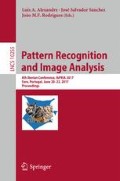Abstract
Sparse representations and methodologies are currently receiving much interest due to their benefits in image processing and classification tasks. Despite the progress achieved over the last years, there are still many open issues, in particular for applications such as object detection which have been much less addressed from the sparse-representation point of view. This work explores several strategies for dictionary usages and study their relative computational and discriminative values in the binary problem of pedestrian classification. Specifically, we explore whether both class-specific dictionaries are really required, or just any of them can be successfully used and, in case that both dictionaries are required, which is the better way to compute the sparse representation from them. Results reveal that different strategies offer different computational-classification trade-offs, and while dual-dictionary strategies may offer slightly better performance than single-dictionary strategies, one of the most interesting findings is that just one class (even the negative, non-pedestrian class) suffices to train a dictionary to be able to discriminate pedestrian from background images.
Work partially supported by Spanish Ministry of Economy (TIN2013-46522-P) and Generalitat Valenciana (PROMETEOII/2014/062).
Access this chapter
Tax calculation will be finalised at checkout
Purchases are for personal use only
References
Castrodad, A., Sapiro, G.: Sparse modeling of human actions from motion imagery. Int. J. Comput. Vis. (IJCV) 100(1), 1–15 (2012)
Dalal, N., Triggs, B.: Histograms of oriented gradients for human detection. In: CVPR (2005)
Deng, W., Hu, J., Guo, J.: In defense of sparsity based face recognition. In: CVPR (2013)
Dollár, P.: Piotr’s image and video matlab toolbox (PMT). http://vision.ucsd.edu/~pdollar/toolbox/doc/index.html
Dollár, P., Belongie, S., Perona, P.: The fastest pedestrian detector in the west. In: BMVC (2010)
Elad, M., Aharon, M.: Image denoising via learned dictionaries and sparse representation. In: CVPR (2006)
Fadili, M.-J., Starck, J.-L., Murtagh, F.: Inpainting and zooming using sparse. Comput. J. 52, 64–79 (2009)
Fan, R.-E., et al.: LIBLINEAR: a library for large linear classification. J. Mach. Learn. Res. 9, 1871–1874 (2008)
Liu, Y., Lasang, P., Siegel, M., Sun, Q.: Multi-sparse descriptor: a scale invariant feature for pedestrian detection. Neurocomputing 184, 55–65 (2016)
Mairal, J., Bach, F., Ponce, J., Sapiro, G.: Online dictionary learning for sparse coding. In: ICML (2009)
Mairal, J., et al.: SPArse Modeling Software (SPAMS). http://spams-devel.gforge.inria.fr
Ren, X., Ramanan, D.: Histograms of sparse codes for object detection. In: CVPR (2013)
Rigamonti, R., Brown, M., Lepetit, V.: Are sparse representations really relevant for image classification? In: CVPR (2011)
Shi, Q., Eriksson, A., van den Hengel, A., Shen, C.: Is face recognition really a compressive sensing problem? In: CVPR, (2011)
Tošić, I., Frossard, P.: Dictionary learning. IEEE Sig. Process. Mag. 28(2), 27–38 (2011)
Wright, J., et al.: Robust face recognition via sparse representation. PAMI 31(2), 210–227 (2009)
Wright, J., et al.: Sparse representation for computer vision and pattern recognition. Proc. IEEE 98(6), 1031–1044 (2010)
Wright, J., Ganesh, A., Yang, A.Y., Zhou, Z., Ma, Y.: Sparsity and robustness in face recognition (2011). CoRR abs/1111.1014
Zheng, J., Jiang, Z., Chellappa, R.: Cross-view action recognition via transferable dictionary learning. IEEE Trans. Image Process. 25(6), 2542–2556 (2016)
Author information
Authors and Affiliations
Corresponding author
Editor information
Editors and Affiliations
Rights and permissions
Copyright information
© 2017 Springer International Publishing AG
About this paper
Cite this paper
Serra-Toro, C., Hernández-Górriz, Á., Traver, V.J. (2017). Strategies of Dictionary Usages for Sparse Representations for Pedestrian Classification. In: Alexandre, L., Salvador Sánchez, J., Rodrigues, J. (eds) Pattern Recognition and Image Analysis. IbPRIA 2017. Lecture Notes in Computer Science(), vol 10255. Springer, Cham. https://doi.org/10.1007/978-3-319-58838-4_11
Download citation
DOI: https://doi.org/10.1007/978-3-319-58838-4_11
Published:
Publisher Name: Springer, Cham
Print ISBN: 978-3-319-58837-7
Online ISBN: 978-3-319-58838-4
eBook Packages: Computer ScienceComputer Science (R0)

